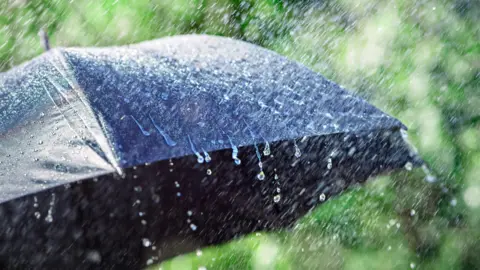 Getty Images/Brian A Jackson
Getty Images/Brian A JacksonTravel is heavily disrupted, with roads and train lines affected, due to heavy rain and wind caused by Storm Bert.
The railway line between Belfast and Antrim is closed, while the line between Belfast and Dublin has reopened after being shut earlier, public transport operator Translink said.
A number of roads have been blocked by fallen debris and motorists warned of difficult driving conditions.
A gritter vehicle got stranded in snow on the Coleraine Mountain Road, which was closed for a period on Saturday morning.
Fallen trees
Yellow warnings for rain, wind and snow are in force for the whole of Northern Ireland until 11:00 GMT on Saturday.
Police officers have advised “extreme caution” to anyone driving in the Causeway Coast and Glens Council area where snow is continuing to cause problems.
In addition to the snow:
- A roof was reportedly blown off a shed in Dungiven, County Londonderry and is obstructing the Ballyquinn Road.
- The Broadway roundabout is closed due to flooding near the Royal Victoria Hospital.
- Belfast’s Ravenhill Road is “impassable” near Martyrs Memorial Church due to flooding.
- A tree and utility lines have come down onto the Belfast Road in Newtownards, partially obstructed the road.
- In County Tyrone the Dergbrough Road, Plumbridge, is fully closed due to a fallen tree.
- The Coast Road in Ballygally is also shut because of a rock fall.
- The Hillhall Road, Lisburn, is closed in both direction at its junctions with the Pinehill Road and Ballylesson Road, due to flooding.
- The 09:30 GMT Ulsterbus from Belfast to Newcastle is cancelled.
- P&O Ferries cancelled Saturday’s 04:00 GMT ferry between Larne and Cairnryan but said passengers would be accommodated on the 08:00 sailing
The TrafficWatchNI service is reporting “very difficult driving conditions” on some higher areas including the Glenshane Pass, Windyhill Road in Limavady and Glenpark Road, Omagh.
Translink has list of all its disrupted bus and rail services on its website.
Allow Twitter content?
Status red warnings
In the Republic of Ireland, about 60,000 homes are without power, after Storm Bert descended overnight.
Met Éireann (the Irish Meteorological Service) had issued red warnings for heavy rain in west Cork and west Galway.
It has warned this could cause severe flooding and damage to property in the affected areas, as well as difficult driving conditions.
Images posted online appeared to show that the River Feale in west Limerick had burst its banks.
In County Donegal a status yellow warning is in force for snow/ice, rain and strong wind until noon.
There has also been major flooding on Bridge Street in Killybegs.
Aside from Donegal, the Electricity Supply Board (ESB) said power cuts were most prevalent in Sligo, Mayo, Galway, Cavan, Monaghan, Kerry and Cork.
Why and how are storms named?

The naming of storms is a practice which helps meteorologists communicate with the public when they need to advise of dangerous or disruptive weather events.
Certain criteria have to be met before a storm is given a name.
Bert is the second named storm of the 2024/25 season which began on 1 September.
It was named by Ireland’s Met Éireann on Thursday because Irish forecasters believed it could bring severe disruption to the Republic of Ireland.
Met Éireann works in partnership with the UK Met Office and the Royal Netherlands Meteorological Institute (RNMI) every year to monitor, classify and names storms.
The three organisations agree an alphabetical list in advance of each season.
Storm Bert was preceded by disruptive snow in some parts of Northern Ireland on Friday.
Source: www.bbc.com…


Leave a Reply